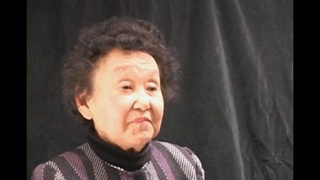Interviews
We’re Still Japanese
And immediately when that happened, I thought, God, what's going to happen to us? We didn't think about being thrown into camps, certainly, but we still -- we had the, "We are Japanese." We're not, we're not Japanese Americans, we were still a Japanese kind of thing. Although we danced jitterbug and listened to swing music, we're still Japanese. And yet we couldn't relate to the Japanese in Japan, so there was really a conflict there. Who are we?
Again, identity was a big problem for me. And I didn't want to be a part of that stuff at all. And yet, golly, I look in the mirror, and I'm Japanese. So this was a major identity problem. And so there was a feeling of guilt, too, being Japanese. Japanese name. Eating gohan. And yet I didn't feel a part of that scene over there because I had not been to Japan at that time, no contact with any of my relatives over there. So internally, it was a terrible time. On the other hand, in the community still, I was not part of the mainstream community. I was still in the Japanese community. And all my friends were Niseis. So we were all somewhat confused, yeah.
Date: February 18, 2002
Location: Washington, US
Interviewer: Alice Ito, John Pai
Contributed by: Denshō: The Japanese American Legacy Project.
Explore More Videos

Growing up in Waikiki
(b. 1924) Political scientist, educator, and administrator from Hawai`i

The philosophy of playing Taiko
(b.1951) Co-founder and managing director of San Jose Taiko.

Learning Japanese traditions by observing his mother and grandmother
(b. 1981) Enka Singer

Receiving a negative reaction from father upon asking about World War II experience
(b. 1939) Japanese American painter, printmaker & professor

Nihongo gakko - Preserving Japanese culture (Spanish)
(b. 1969) Former president of Centro Nikkei Argentino.

Not wanting to stand out as a foreigner
Sansei Japanese American living in Japan and Kendo practioner

Memories of dusty conditions at Minidoka incarceration camp
(b. 1923) Nisei from Washington. Resisted draft during WWII.

Have compassion for all of humanity
(b. 1923) Nisei from Washington. Resisted draft during WWII.

Identity crisis (Spanish)
(b. 1969) Former president of Centro Nikkei Argentino.

Never sang Enka outside the family
(b. 1981) Enka Singer

Both Japanese and American identities though Japanese dance
(1918-2023) Nisei Japanese kabuki dancer

Family life in a Japanese Canadian internment camp in Slocan
(b. 1920) Incarcerated during World War II. Active member of the Japanese Canadian community


Results of being more American than Japanese
(1924-2018) Researcher, Activist

Trying to convey the meaning of the songs
(b. 1981) Enka Singer
